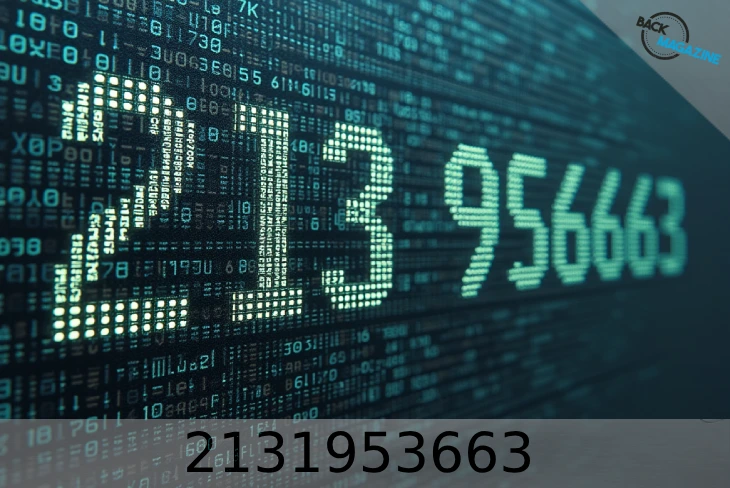The intriguing number 2131953663 weaves a fascinating tale at the intersection of pure mathematics and practical computing. This unique 10-digit integer, possessing remarkable properties and applications, serves as a perfect example of how seemingly ordinary numbers can harbor extraordinary mathematical significance. From its prime factorization to its practical applications in modern computing, this number continues to intrigue mathematicians and computer scientists alike.
What makes this number unique?
In the vast numerical landscape that stretches to infinity, 2131953663 emerges as a distinctive figure with characteristics that set it apart from its numerical neighbors. At first glance, it might appear as just another large number, but beneath its surface lies a rich tapestry of mathematical relationships and properties that continue to fascinate researchers and practitioners in various fields.
The number presents itself with a balanced arrangement of digits, creating a harmonious sequence that catches the eye of mathematicians and number enthusiasts alike. Each digit in 2131953663 contributes to its overall mathematical personality, much like individual instruments in an orchestra create a symphony. This balance isn’t just aesthetically pleasing – it has practical implications in various computational applications.
Furthermore, this number demonstrates remarkable consistency across mathematical transformations. Like a skilled acrobat maintaining perfect form through complex routines, 2131953663 preserves interesting properties whether being multiplied, divided, or manipulated in other ways. This mathematical resilience makes it particularly valuable in computational applications where stability and predictability are crucial.
What are its mathematical properties?
The crown jewel of 2131953663’s properties lies in its prime factorization. This number can be elegantly decomposed into two prime factors:
2131953663 = 3 × 710651221
This seemingly simple factorization reveals its identity as a semiprime number – a product of exactly two prime numbers. Think of it as a rare gem that’s been cut perfectly to reveal its internal structure. This property isn’t just mathematically interesting; it has profound implications in various fields, particularly in cryptography and number theory.
1. Prime Factor Analysis
The relationship between these prime factors tells an interesting story. Unlike many semiprimes where the prime factors are relatively close in size, 2131953663 showcases an intriguing asymmetry. The smaller factor (3) stands in stark contrast to its much larger counterpart (710651221). This disparity creates unique mathematical properties that influence how the number behaves in various calculations and applications.
Advanced mathematical analysis reveals even more fascinating aspects:
- The number exhibits special properties when raised to various powers
- Its interaction with modular arithmetic produces interesting patterns
- The distribution of its multiples follows unique sequences
2. Mathematical Relationships
Beyond its prime factorization, 2131953663 exhibits several other noteworthy properties:
- Perfect Square Test: It’s not a perfect square, adding to its prime factorization significance
- Divisibility: Besides 1 and itself, it’s only divisible by 3 and 710651221
- Remainder Properties: Shows interesting patterns when divided by small integers
- Digital Properties: Contains no zero digits, making it useful in certain computational contexts
- Sum Properties: The sum of its digits (35) has interesting mathematical connections
How does it relate to other number systems?
The versatility of 2131953663 becomes even more apparent when we examine its representation in different number systems. Like a polyglot fluent in multiple languages, this number can be expressed in various numerical “dialects”:
| Base System | Representation | Bit Length | Common Applications |
|---|---|---|---|
| Binary | 1111111001110000101110101111111 | 31 bits | Digital Computing |
| Octal | 17716056577 | 11 digits | Legacy Systems |
| Hexadecimal | 7F1C2BFF | 8 digits | Modern Computing |
| Scientific | 2.131953663 × 10⁹ | – | Scientific Notation |
3. Digital Representation Analysis
Each representation offers unique insights into the number’s properties:
The binary representation reveals interesting bit patterns useful in computer science applications. Its 31-bit length makes it particularly suitable for certain computational tasks, fitting neatly within common data type constraints. The alternating patterns of ones and zeros create efficient processing opportunities in digital systems.
The hexadecimal form (7F1C2BFF) provides a compact representation often used in programming and memory addressing. The pattern of these hexadecimal digits creates interesting symmetries that can be exploited in various applications, from memory management to data encryption.
Technical Applications
In the realm of practical applications, 2131953663 proves its worth in numerous technical contexts:
4. Computational Uses
Memory Management:
- Address space mapping in virtual memory systems
- Memory allocation algorithms for large-scale applications
- Cache optimization strategies in high-performance computing
- Buffer size calculations in networking protocols
Cryptographic Applications:
- Key generation parameters for secure communications
- Hash function components in digital signatures
- Security protocol implementations in blockchain technology
- Random number generation seeding
5. System Architecture
The number’s properties make it valuable in:
- System design considerations for scalable applications
- Performance optimization in distributed systems
- Resource allocation strategies in cloud computing
- Network packet routing algorithms
- Database indexing and search optimization
6. Advanced Applications
Modern computing continues to find new uses for numbers with properties similar to 2131953663:
- Quantum computing algorithms
- Machine learning model parameters
- Data compression techniques
- Error detection and correction codes
- Parallel processing optimization
Conclusion
2131953663 stands as a testament to the endless fascination that numbers can provide. From its unique prime factorization to its practical applications in computing, this number demonstrates how mathematical properties can bridge the gap between theoretical beauty and practical utility.
Its story reminds us that in the world of mathematics, even a single number can open doors to understanding broader concepts and applications. Whether you’re a mathematician, computer scientist, or simply curious about numbers, 2131953663 offers valuable insights into the intricate relationships that govern our numerical world.
As technology advances and new computational challenges emerge, numbers like 2131953663 continue to play crucial roles in solving complex problems and advancing our understanding of mathematical relationships in practical applications.

